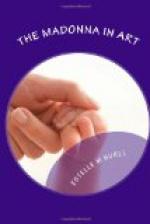Passing from the sculpture of Florence to its painting, it is fitting that we mention first of all the friend and fellow-pupil of the Umbrian Perugino, Lorenzo di Credi. The two had much in common. Trained together in the workshop of the sculptor Verrocchio, in those days of intense religious stress, they both became followers of the prophet-prior of San Marco, Savonarola. Their religious earnestness naturally found expression in the beautiful subject of the Madre Pia. The Florentine artist, though not less devout than his friend, introduces into his work an element of joy, characteristic of his surroundings, and more attractive than the somewhat melancholy types of Umbria. His Adoration, in the Uffizi, is an admirable example of his best work. Following the fashion made popular by the Della Robbias, the artist chose for his composition the round picture, or tondo. By this elimination of unnecessary corners, the attention centres in the beautiful figure of the Virgin, which occupies a large portion of the circle. In exquisite keeping with the modest loveliness of her face, a delicate, transparent veil is knotted over her smooth hair, and falls over the round curves of her neck. In expression and attitude she is the perfect impersonation of the spirit of humility, joyfully submissive to her high calling, reverently acknowledging her unworthiness.
This picture may be taken as a typical example of the subject in Florentine painting. Lorenzo himself repeated the composition many times, and numerous other works could be mentioned, strikingly similar in treatment, by Ghirlandajo, in the Florence Academy; by Signorelli, in the National Gallery; by Albertinelli, in the Pitti; by Filippo Lippi, in the Berlin Gallery; by Filippino Lippi, in the Pitti; and so on through the list.
In many cases the subject seems to have been chosen, not so much from any devotional spirit on the part of the painter, as from force of imitation of the prevailing Florentine fashion. This is especially true in the case of Filippo Lippi, who does not bear the best of reputations. Although a brother in the Carmelite monastery, his love of worldly pleasures often led him astray, if we are to believe the gossip of the old annalists. We may allow much for the exaggerations of scandal, but still be forced to admit that his candid realism is plain evidence of a closer study of nature than of theology.
Browning has given us a fine analysis of his character in the poem bearing his name, “Fra Lippo Lippi.” The artist monk, caught in the streets of the city on his return from some midnight revel, explains his constant quarrel with the rules of art laid down by ecclesiastical authorities. They insist that his business is “to the souls of men,” and that it is “quite from the mark of painting” to make “faces, arms, legs, and bodies like the true.” On his part, he claims that it will not help the interpretation of soul, by painting body ill. An intense lover of every beautiful




